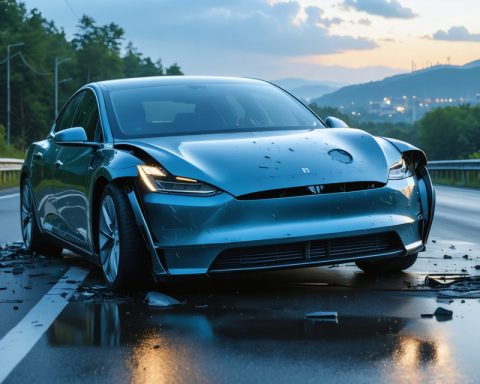- Electric vehicles (EVs) are transforming urban life, offering quieter and cleaner alternatives to traditional cars.
- EVs produce no tailpipe emissions, significantly improving air quality and reducing pollutants that cause health issues.
- The adoption of EVs is reshaping city planning with increased infrastructure like charging stations and smart grids.
- Challenges include the sourcing and disposal of lithium batteries, though innovations in materials and recycling are underway.
- Government incentives, such as tax breaks and subsidies, are making EVs more accessible and appealing to consumers.
- Ultimately, EVs serve as catalysts for sustainable change, enhancing urban living and environmental awareness.
The sun peeks over the skyline, casting a golden hue over a bustling cityscape. As the world awakens, the streets hum with the quiet energy of electric vehicles (EVs), marking a significant shift in urban life that many city dwellers have embraced wholeheartedly. These silent pioneers glide by, leaving behind nothing but a whisper of progress and a promise of a cleaner tomorrow.
Gone are the days when urban centers reeked of exhaust fumes, their air choked with the remnants of gasoline-powered engines. Today, EVs spearhead a movement that marries innovation with environmental responsibility. Cities, once buzzing with the chaotic symphony of combustion engines, now play host to a quieter, more harmonious orchestra.
The benefits of this electric transition are palpable. Air quality improves dramatically, with fewer emissions painting clearer skies for everyone to enjoy. According to the Environmental Protection Agency (EPA), EVs produce no tailpipe emissions, leading to a significant reduction in air pollutants that contribute to smog and respiratory problems. In turn, this elevates the quality of life, promoting healthier lifestyles for urban residents.
Moreover, the economic ripple of EV adoption extends beyond the individuals who own them. Urban planners capitalize on this shift by designing cities that cater to a greener future—a landscape punctuated by charging stations and smart grids, encouraging sustainable development. The increase in charging infrastructure, supported by initiatives like the U.S. Department of Transportation’s push for Electric Vehicle Corridors, enables seamless integration of EVs into daily life, curtailing range anxiety that previously deterred potential adopters.
Not all change comes without its challenges, however. Transitioning to electric comes with its own hurdles, especially concerning the sourcing and disposal of lithium batteries. But innovative strides continue apace, with companies researching alternative materials and recycling methods to address these issues, ensuring a sustainable lifecycle for electric vehicles.
Incentives further fuel the EV momentum. Governments worldwide offer tax breaks and subsidies, making electric a more viable and attractive choice for the average consumer. As the cost of EVs falls and their range expands, the barriers to entry continue shrinking, democratizing the future of green transportation.
Ultimately, the embrace of electric vehicles in urban settings heralds a new dawn, where cities pulsate with renewed vigor and environmental awareness. The antiquated sounds of our day-to-day grind are replaced with a serene promise—a revolution not only in how we travel but in how we perceive and interact with our environments.
The takeaway here? Electric vehicles are more than just a means of transport; they are catalysts for change. They beckon us to imagine a future where our cities breathe easier, our streets flow more smoothly, and our daily journeys are powered by the promise of sustainability. As we embrace this silent revolution, we take one significant stride closer to a world where innovation and conservation coexist seamlessly.
Revolutionize Your Commute: How Electric Vehicles Are Transforming Urban Life
The Rise of Electric Vehicles in Urban Landscapes
The dawn of electric vehicles (EVs) has reshaped the urban landscape, significantly improving both environmental conditions and the quality of life for city dwellers. As cities evolve to accommodate these vehicles, they embody a modern synergy between technology, sustainability, and urban planning.
The Pivotal Role of Electric Vehicles
The transition to electric vehicles brings a myriad of benefits, prominently featuring a dramatic reduction in air pollutants. Unlike traditional vehicles, EVs produce zero tailpipe emissions, significantly lowering the carbon footprint associated with transport. According to the Environmental Protection Agency, this reduction in emissions translates to healthier air quality, diminishing the prevalence of respiratory-related health issues and promoting overall public health.
Urban Planning and Infrastructure Development
As EVs become more prevalent, urban planners are adapting cityscapes to support this green transition. The deployment of EV charging stations is critical to the infrastructure supporting electric mobility. Initiatives such as the U.S. Department of Transportation’s development of Electric Vehicle Corridors are pivotal in alleviating range anxiety—a chief concern for potential EV users. These corridors ensure that charging stations are readily accessible, making long-distance travel feasible and more efficient.
Economic Impacts and Incentives
Electric vehicles not only influence environmental and health sectors but also stimulate economic growth. The EV industry has spurred job creation in areas such as manufacturing, infrastructure development, and maintenance. Additionally, government-backed incentives, including tax rebates and subsidies, make electric vehicles an economically attractive option. As reported by the International Council on Clean Transportation, these incentives lower the financial barrier for consumers, encouraging broader adoption.
Challenges and Solutions in EV Adoption
Despite the enthusiasm surrounding EVs, challenges persist, particularly regarding the sourcing and disposal of lithium-ion batteries used in EVs. Research into alternative materials and development of efficient recycling methods are crucial steps toward establishing a sustainable lifecycle for these vehicles.
Market Trends and Forecasts
The EV market is poised for rapid growth. According to BloombergNEF, EVs are projected to account for 58% of global passenger vehicle sales by 2040. This projection signals a pivotal shift towards cleaner transportation, with automakers increasingly investing in EV technologies and innovations.
How-To Steps & Life Hacks: Maximizing Your EV Experience
1. Plan Your Route: Utilize apps and services that map out charging stations to optimize your travel routes.
2. Incentives and Rebates: Research and apply for available government incentives to offset purchase and installation costs.
3. Routine Maintenance: While EVs require less maintenance than conventional cars, routine checks of the battery and system software updates ensure optimal performance.
Pros & Cons Overview
Pros:
– Environmental Benefits: Zero emissions and reduced noise pollution.
– Lower Operating Costs: Less maintenance and lower fueling costs compared to gasoline-powered vehicles.
– Government Incentives: Tax credits and rebates enhance affordability.
Cons:
– Initial Cost: Higher upfront cost than some conventional vehicles.
– Limited Range: Although improving, the range can still be a concern for longer trips.
– Charging Infrastructure: In many areas, charging accessibility can still be limited.
Actionable Recommendations
– Consider Energy Sources: Investigate the energy mix of your local grid to maximize environmental benefits when charging your EV.
– Stay Informed: Keep abreast of advancements in battery technology and government policies to make informed purchasing decisions.
– Advocate for Infrastructure: Support local initiatives and policies that promote the expansion of EV infrastructure.
For more insights into how electric vehicles are revolutionizing the future of transportation, visit the Environmental Protection Agency or check out the latest trends and innovations at Bloomberg.















